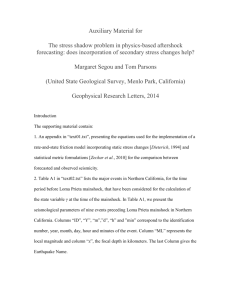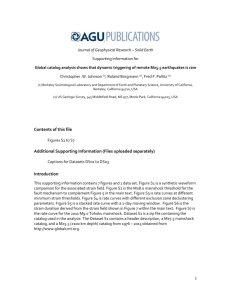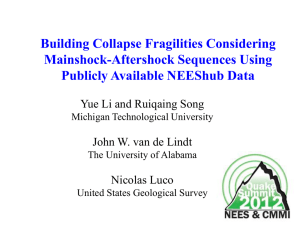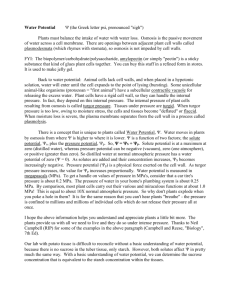jgrb50926-sup-0001-documentS1
advertisement
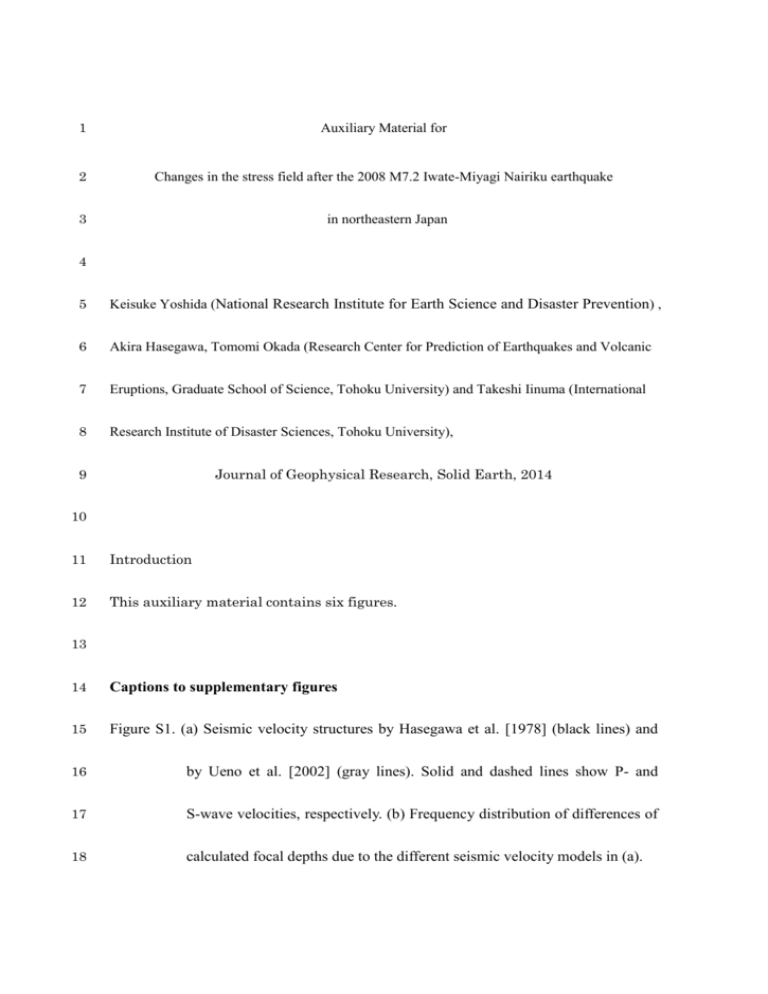
1 Auxiliary Material for 2 Changes in the stress field after the 2008 M7.2 Iwate-Miyagi Nairiku earthquake 3 in northeastern Japan 4 5 Keisuke Yoshida (National Research Institute for Earth Science and Disaster Prevention) , 6 Akira Hasegawa, Tomomi Okada (Research Center for Prediction of Earthquakes and Volcanic 7 Eruptions, Graduate School of Science, Tohoku University) and Takeshi Iinuma (International 8 Research Institute of Disaster Sciences, Tohoku University), Journal of Geophysical Research, Solid Earth, 2014 9 10 11 Introduction 12 This auxiliary material contains six figures. 13 14 Captions to supplementary figures 15 Figure S1. (a) Seismic velocity structures by Hasegawa et al. [1978] (black lines) and 16 by Ueno et al. [2002] (gray lines). Solid and dashed lines show P- and 17 S-wave velocities, respectively. (b) Frequency distribution of differences of 18 calculated focal depths due to the different seismic velocity models in (a). 19 Figure S2. Distribution of hypocenters relocated in the present study. The figure on the 20 left shows a map view. The five figures on the right show along-fault 21 vertical cross-sections along lines E, F, G, H and I in the map view. Blue 22 circles represent the relocated hypocenters. Others are the same as in Fig.2. 23 Figure S3. Examples of focal mechanism solutions determined by the present study. (a) 24 focal mechanisms evaluated as rank A and (b) those as rank B by the 25 criteria of Hardebeck and Shearer [2002]. (c) and (e) show the frequency 26 distributions of the number of polarity data used for determinations of focal 27 mechanisms whose ranks are A and B, respectively. (d) and (f) show the 28 maximum azimuthal gap of polarity data used for determinations of focal 29 mechanisms whose ranks are A and B, respectively. 30 Figure S4. Comparison of focal mechanisms determined in the present study with those 31 determined by different seismic velocity models and hypocenter locations. 32 Differences are shown as frequency distributions of angular differences of 33 P-axis. (a) Difference with those determined by using the velocity model of 34 Hasegawa et al. [1978] and hypocenter locations in the JMA catalogue, (b) 35 with those determined by using the velocity model of Ueno et al. [2002] 36 and hypocenter locations in the JMA catalogue, and (c) with those 37 determined by using the velocity model of Ueno et al. [2002] and 38 hypocenter locations relocated in the present study. 39 Figure S5. Distribution of focal mechanism solutions before the mainshock, determined 40 in this study. “Beach balls” represent the focal mechanisms. The figure on 41 the left shows a map view. The four figures on the right show across-fault 42 vertical cross-sections along A-A’, B-B’, C-C’, and D-D’ in the map view. 43 Other details are the same as in Fig. 4. 44 Figure S6. Distribution of focal mechanism solutions after the mainshock, determined in 45 this study. “Beach balls” represent the focal mechanisms. The figure on the 46 left shows a map view. The four figures on the right show across-fault 47 vertical cross-sections along A-A’, B-B’, C-C’, and D-D’ in the map view. 48 Other details are the same as in Fig. 4. 49 Figure S7. Distribution of P-axis orientations of focal mechanisms determined in this 50 study from (a) before and (b) after the mainshock. Length and color (scale 51 is shown at the bottom) of bar corresponds to the plunge and azimuth of the 52 P-axes, respectively. Gray contour indicates the coseismic slip model of 53 Iinuma et al. [2009]. 54 Figure S8. Distribution of T-axis orientations of focal mechanisms determined in this 55 study from (a) before and (b) after the mainshock. Length and color (scale 56 is shown at the bottom) of bar corresponds to the plunge and azimuth of the 57 T-axes, respectively. Gray contour indicates the coseismic slip model of 58 Iinuma et al. [2009]. 59 Figure S9. Rose diagrams showing the azimuth of 𝜎1 axis. In (a) and (b), azimuths of 60 𝜎1 axis in the entire area before and after the mainshock are shown, 61 respectively. In (c), azimuths of 𝜎1 axis in the large slip area (enclosed in 62 Fig. 7b) after the mainshock are shown. 63 Figure S10. Comparison of principal stress orientations before and after the mainshock. 64 The stress orientations after the mainshock were estimated at the same 65 locations before the mainshock as in Figure 6. In (a) and (b), orientations of 66 the best-fit 𝜎1 axes are shown by bars before and after the mainshock, 67 respectively. They are colored by depth. In (c), 95% confidence limits of 68 the 𝜎1 and 𝜎3 axes before and after the mainshock are plotted by using 69 different color contours. 95% confidence limits of the 𝜎1 and 𝜎3 axes 70 before the mainshock are shown by orange and light blue contours, 71 respectively, on lower focal hemispheres. Those after the mainshock are 72 shown by red and blue contours, respectively. Best orientations of the 𝜎1 73 and 𝜎3 axes are shown by circles. 74 Figure S11 Comparison of static stress changes calculated using different values of 75 Poisson’s ratio. In (a) and (b), gray circles indicate differential stresses 76 calculated by assuming Poisson’s Ratio as 0.18 and 0.31, respectively, 77 normalized by those assuming Poisson’s Ratio as 0.25 at the same locations. 78 In (c) and (d), gray circles indicate angular differences of 𝜎1 axis between 79 static stress changes calculated by assuming Poisson’s Ratio as 0.25 and 80 those assuming as (c) 0.18 and (d) 0.31 at the same locations. Solid curves 81 show average values. 82 Figure S12. Estimated distributions of 𝜎1 axis orientations after the mainshock given 83 by calculating the sum of stress tensors before the mainshock and the static 84 stress change. The static stress change was based on the slip model moved 85 horizontally without rotation from the model of Iinuma et al. [2009], in 86 order to be consistent with the aftershock hypocenters. They are plotted 87 separately into three depth ranges, 0–3 km, 3–5 km, and 5–8 km, so that 88 they do not overlap. Assumed differential stresses before the mainshock are 89 (a) 100 MPa, (b) 50 MPa, (c) 30 MPa, (d) 20 MPa, (e) 10 MPa, and (f) 5 90 MPa. Other details are the same as in Fig. 6. 91 Figure S13. Estimated distributions of 𝜎1 axis orientations after the mainshock given 92 by calculating the sum of stress tensors before the mainshock and the static 93 stress change. The static stress change was based on the slip model moved 94 horizontally without rotation from the model of Hikima and Koketsu (2013) 95 in order to be consistent with the aftershock hypocenters. They are plotted 96 separately into three depth ranges, 0–3 km, 3–5 km, and 5–8 km, so that 97 they do not overlap. Assumed differential stresses before the mainshock are 98 (a) 100 MPa, (b) 50 MPa, (c) 30 MPa, (d) 20 MPa, (e) 10 MPa, and (f) 5 99 MPa. Other details are the same as in Fig. 6. 100
